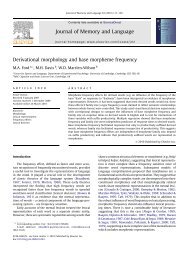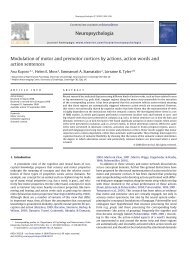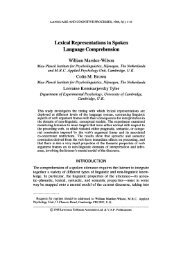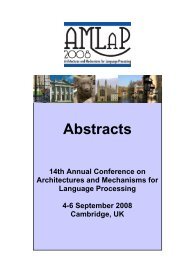Towards a psychological basis for a theory of anaphora - Centre for ...
Towards a psychological basis for a theory of anaphora - Centre for ...
Towards a psychological basis for a theory of anaphora - Centre for ...
You also want an ePaper? Increase the reach of your titles
YUMPU automatically turns print PDFs into web optimized ePapers that Google loves.
suggests that five year-olds also have problems with<br />
pronoun anaphors in the comprehension <strong>of</strong> utterances.<br />
The experiment used stimuli <strong>of</strong> the following sort:<br />
1) Jan was trying to catch some butterflies<br />
2al The butterflies had beautiful wints (wings)<br />
and...<br />
2b) They had beautiful wints (wings) and.. .<br />
The children heard short texts, containing these<br />
two-sentence pairs - i.e. (1) followtd by either (2a)<br />
or (2b) - and their task was to press a response key<br />
whenever they heard a "mispronounced" word. In the<br />
example here, the word "wings" is mispronounced as<br />
"wints" (the actual experiment was run in Dutch, and the<br />
above example is a loose translation <strong>of</strong> one <strong>of</strong> the<br />
stimulus sets). Earlier experiments by Cole and Jakimik<br />
(1980) had used this task successfully with first-grade<br />
children.<br />
The reason <strong>for</strong> using the mispronunciation detection<br />
task here was that reaction-times in this task are<br />
facilitated when the original word - the source <strong>for</strong> the<br />
mispronounced word - is more contextually predictable.<br />
To determine that a word has been mispronounced, one<br />
needs to establish what the source word was, and this<br />
process is apparently facilitated when the contextual<br />
constraints on the source word are stronger. In the<br />
present example, the word "wings" (the source <strong>for</strong><br />
"wints") is only predictable if one knows that it is<br />
"butterflies" that are the subject <strong>of</strong> the sentence. But<br />
in sentences like (2b) one can only know this if one has<br />
established that the antecedent <strong>of</strong> "They" is indeed<br />
"butterflies". Thus, if there are any developmental<br />
differences in childrens' ability to resolve pronoun<br />
anaphors on-line, then this should produce a slower<br />
response in (2b) relative to (2a), where "butterflies"<br />
are explicitly mentioned in the sentence.<br />
Table 2<br />
Mean Mispronunciation Detection Latencies (msec)<br />
Continuation Type<br />
Age-qroup Nounphrase Pronoun Diff.<br />
5 Years 709 769 60'<br />
7 Years 560 561 1<br />
10 Years 495 500<br />
........................................................<br />
5<br />
The results are given in Table 2, <strong>for</strong> the three<br />
age-groups we tested. The seven and the ten year-old<br />
groups show no differences between the pronoun and the






